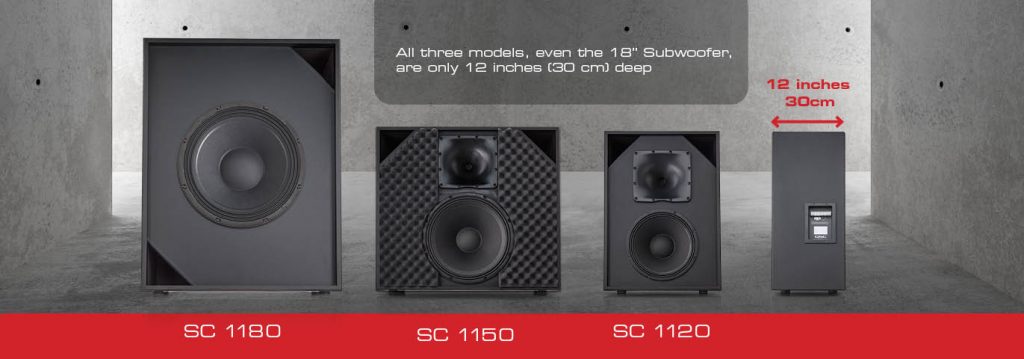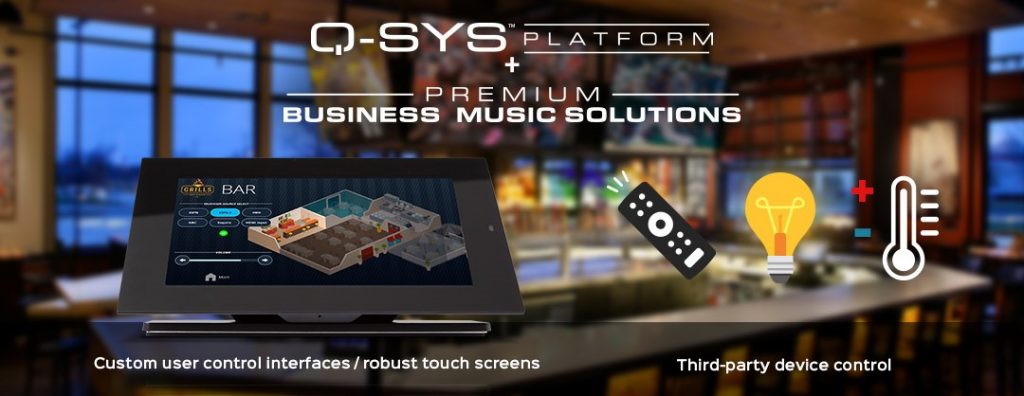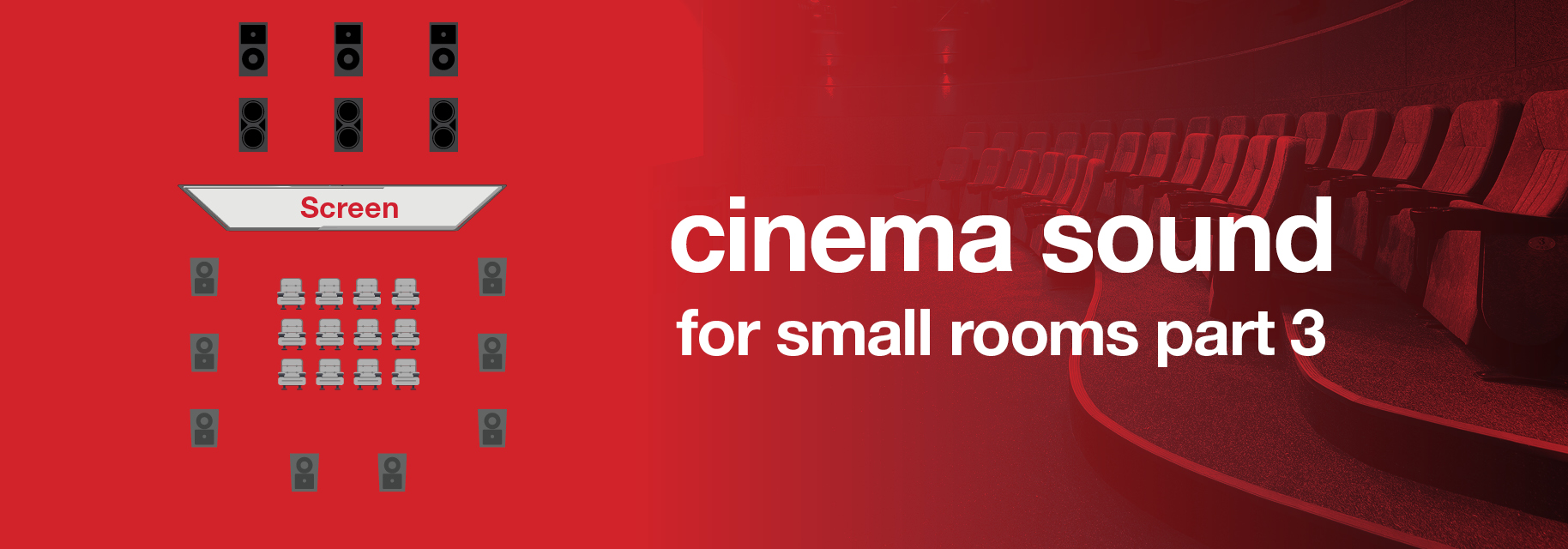In this third and final installment of our look at small rooms, we’ll focus on Q-SYS and how it can be used for multi-room systems, especially “cinema on demand” rooms in commercial multiplex sites.
As before, let’s look at room sizes of about 10m, or 33 ft. in length. We’ll also assume the use of digital projection and a perforated screen. While we can support direct view LED screens, we will save that topic for another time.
To re-cap, QSC small room loudspeaker systems share the common characteristic of shallow depth. Both screen channel models and the 18” subwoofer are only 12 inches (30cm) deep.

For this discussion, let’s assume the same basic speaker solutions as Part 2 – the SC 1120 and SC 1150 Screen Channels and the SB 1180 subwoofer – but for audio processing and control, we’ll use Q-SYS. The remaining key product decisions are related to additional Alternative Content and AV capability as well as control requirements. Before going straight to product selection, it is a good idea to understand the goals and applications for the rooms in question.
Remember that Q-SYS is so much more than a cinema processor, and it’s not just for large PLF (Premium Large Format) rooms either. Depending on what you are trying to accomplish, Q-SYS offers many features and functions that would normally add cost and complexity if using a competitor’s solution, even for small room applications. If you want to go beyond normal D-Cinema and offer a flexible environment for movies, meetings, gaming and more, then Q-SYS is the answer.
Since the rooms should handle content from a satellite receiver, Blu-ray disc player, or a laptop, an HDMI input is required. The DCIO-H should be part of the system design. The DCIO-H provides an HDMI “pass-through” connection. The audio from the HDMI source is routed for further processing within Q-SYS, and the output connector feeds the video to the HDMI input of the projector. DTS and Dolby surround decoding (Dolby Digital Plus™ and Dolby® Surround 7.1, and DTS-HD®) is provided by the DCIO-H, and matrix surround decoding is done in Q-SYS. If additional HDMI inputs are required, Q-SYS controls HDMI switchers from several 3rd party suppliers.

To support a DCI-compliant server and projector, the DCIO-H has a 16-channel AES digital audio input for easy connection via a pair of RJ-45 jacks to commonly used D-Cinema servers, such as Doremi, GDC, Dolby and Barco.
The DCIO-H also provides audio outputs for Infrared Assisted Listening and Narration systems and a passive or powered projection booth monitor speaker. A mic/line XLR connector and a stereo mini-jack complete the audio input options. Four relays are provided for controlling external devices, such as dimmers and masking systems, via dry contact closures using Q-SYS control GUI’s and scripting. GPI automation inputs and an RS-232 serial port round out the control options.
Audio outputs to the DPA-Q amplifiers are via Ethernet. The Q-SYS Q-LAN protocol supports all audio transport and control over standard 1G Ethernet. The network connection simplifies amplifier wiring and signal routing. A single DPA 4K8Q 8-channel amplifier can power an entire 7.1 system. DPA-Q amplifiers provide additional analog mic/line audio inputs and GPIO ports for even greater flexibility. If you want a mixer with auto-mixing capability, use the inputs on the amps and create your AV mixer in Q-SYS with no need for additional hardware.
There are several processing options available with Q-SYS. A single Core 110c could be used for each room, but it may be more economical to use a larger Core 510c for multiple rooms. Depending on the complexity of the total design, a single Core 510c processor should be able to handle as many as eight rooms. If you are concerned about too many rooms on a single processor, Q-SYS supports redundant Cores and networks with an automatic changeover in the event of a failure. And what about control? With Q-SYS, you can control almost anything used in cinema from servers to projectors, lights, signs; you name it. Easily create a custom User Control Interface for an iPad or any of our touch screen controllers that make control a piece of cake.
Another element that, based on my experience, is critical for any theatre, large or small, is the ability to make sure it looks and sounds the way it should with routine measurement of sound and light. To this end, the LSS 200 is the right tool for the job. The LSS 200 Light and Sound Sensor is a PoE device that connects to the automation network. When placed in the room, it can measure the light level and color from the projector, sound levels from the sound system, and even report the temperature in the room. Adding the LSS 200 to a Q-SYS system makes quality assurance simple.
Extending Q-SYS Capability
The QSC NV-32-H is a network video device that is controlled by Q-SYS. The NV-32-H can run in encoder mode to place HDMI video content on the network and in decoder mode to receive network video content and play it back on a local HDMI display. It also functions as a three-input HDMI switcher. NV-32-H is an ideal way to equip your cinema for business meeting rentals. For example, one NV-32-H at a presenter’s podium can provide a laptop input for transmission to another NV-32-H at the projector. The NV-32-H at the projector can also serve as a local three-input HDMI switcher for things like Blu-ray disc players or satellite receivers.
QSC offers a full line of control and audio products for the rest of the multiplex. If you need music and paging in the lobby, lounge, restaurant, or game room, QSC has you covered. All you need to add is QSC amps and a selection of our full-range surface and ceiling mount speakers since the control and processing is already part of your existing Q-SYS Core. In most cases, the Core Processor has enough DSP processing power to run the rest of the complex as well as the cinema auditorium.

Sample System
For these price calculations, we will assume one-fourth of a Core 510c. That could be a single Core running four rooms or a pair of redundant cores running eight rooms.

QSC Cinema Application Engineers are ready to help with system specifications. To get started, we will need to know details of the room, or rooms (drawings preferred), performance requirements, and other gear to be integrated into the system. If this sounds like a great solution for your small rooms, let us help you configure a system to meet all of your audio and control requirements.

Why people still use to read news papers when in this technological world everything is presented on net?
Автор статьи предлагает разные точки зрения на обсуждаемую проблему, позволяя читателям ознакомиться с различными аргументами и сделать собственные выводы.
Актуальные каталоги публикуют кракен тор ссылка с указанием статуса работоспособности в реальном времени для нахождения рабочих зеркал при технических работах или атаках.
Free Online Jigsaw Puzzle https://addons.mozilla.org/zh-TW/firefox/user/13330707/ play anytime, anywhere. Huge gallery of scenic photos, art and animals, customizable number of pieces, autosave and full-screen mode. No registration required – just open the site and start solving.
Вызов электрика https://vash-elektrik24.ru на дом в Москве: оперативный выезд, поиск и устранение неисправностей, установка розеток и выключателей, подключение техники, ремонт проводки. Квалифицированные мастера, точные цены, гарантия на работы и удобное время приезда.
Хочешь сдать авто? продать авто срочно спб быстро и безопасно: моментальная оценка, выезд специалиста, оформление сделки и мгновенная выплата наличными или на карту. Покупаем автомобили всех марок и годов, включая битые и после ДТП. Работаем без скрытых комиссий.
Все современные специальности ВГУ им. Машерова в одном разделе: список факультетов, направления подготовки, краткие описания программ, длительность обучения, квалификация выпускника и основные дисциплины. Помогаем абитуриентам выбрать подходящую профессию и траекторию обучения.
Женский портал https://forthenaturalwoman.com о жизни, красоте и вдохновении: мода, уход за собой, здоровье, отношения, карьера и личные финансы. Полезные статьи, честные обзоры, советы экспертов и истории реальных женщин. Присоединяйтесь к сообществу и находите идеи для себя каждый день.
Онлайн авто https://autoindustriya.com.ua портал: всё об автомобилях и автожизни. Обзоры и сравнения моделей, тест-драйвы, лайфхаки по ремонту и обслуживанию, информация о кредитах и лизинге, новости рынка. Помогаем выбрать машину, понять тонкости владения и сэкономить на содержании.
Портал о ремонте https://remont-sam.com и строительстве: от подготовки проекта и сметы до отделки и декора. Подробные инструкции, обзоры инструментов, рейтинги материалов, фото-примеры и лайфхаки. Удобная навигация по темам помогает быстро найти нужное решение для вашего объекта.
Строительный портал https://garden-story.com для профессионалов и частных мастеров: статьи и инструкции по ремонту, отделке и строительству, обзоры материалов и инструментов, калькуляторы, сметы, фото-примеры и советы экспертов. Всё, чтобы грамотно спланировать и выполнить работы.
Свежие новости https://ukrportal.com.ua Украины и мира: политика, экономика, общество, происшествия, аналитика и авторские материалы. Оперативные обновления 24/7, проверенные факты и объективная подача. Следите за ключевыми событиями, которые формируют будущее страны и всего мира.
Новости Украины https://ukrinfo24.com.ua и мира: оперативная информация, разбор ключевых событий, интервью, репортажи и аналитика. Только проверенные источники и объективная подача. Будьте в курсе того, что происходит в стране и на международной арене прямо сейчас.
Актуальные новости https://ukrmedia24.com.ua Украины и мира в одном месте: главные события дня, обзоры, комментарии экспертов, репортажи и эксклюзивные материалы. Политика, экономика, технологии, культура и спорт. Быстро, достоверно и удобно для ежедневного чтения.
Все новости https://uanews24.com.ua Украины и мира — быстро, достоверно и понятно: события в политике, экономике, науке, культуре и спорте. Подробные обзоры, интервью и аналитика помогают увидеть полную картину происходящего. Ежедневные обновления и удобная навигация.